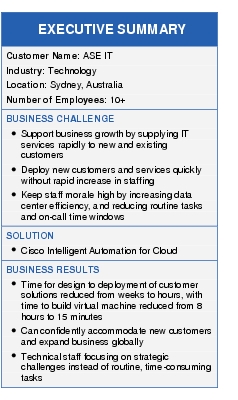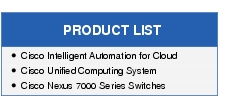Cisco Intelligent Automation for Cloud helps ASE IT improve internal efficiency, add high-value services, and use technical staff more strategically.

Business Challenge
Some of the largest companies on the Australia Securities Exchange have chosen ASE IT for their cloud solutions provider. ASE has had a major impact on the country's technology landscape in a relatively short period of time. Founded in 2001, ASE is an excellent example of how smaller companies can use data center automation to gain a fair chance to compete effectively. That perception is substantiated by the 2012 Longhaus Research Report, which ranked ASE IT as one of the top-ten service providers in Australia. The report compares Australia's 150+ cloud providers and ranks them according to detailed analysis of each company's products, services, and security, focusing on customer trust and satisfaction.
Achieving this degree of success and recognition is a validation of several important strategic decisions by the ASE management team. Perhaps the most important of these decisions occurred in 2006 when the company moved toward delivery of services in the cloud. "We knew that we were ahead of the market," says Andrew Sjoquist, chief executive officer, "but we recognized that it was the best way to respond to our customers' desire to have a fixed price service delivery model."
In addition, cloud services helped enable the company to broaden its base of small and medium-sized businesses. "These customers want an enterprise quality solution but do not have the capital budgets to build those solutions for themselves. We embarked on a journey to build cloud services based on best-of-breed technology and deliver services from the desktop to the data center," says Sjoquist.
Good standardization of important data center elements such as infrastructure is vital to cloud success. ASE knew this early in its history and made the strategic decision to standardize on Cisco and NetApp for its six, soon to be 10, data centers in Australia and the United States. "We decided that building stronger relationships with vendors like Cisco would result in greater efficiency and access to innovative technology to stay competitive," says Sjoquist. "The ability to increase our customer base, touch so many vertical markets, and expand our global presence is because the infrastructure that we built is extremely nimble and agile."
ASE quickly grew its solutions portfolio to four major offerings: ASE AppCloud, ASE CPUCloud, ASE StorCloud, and ASE UCCloud. Even as its portfolio and new accounts were growing at a rapid rate, the company made another strategic decision to maintain a small technical team and support it with powerful IT automation technologies. Fifteen senior engineers support ASE's global infrastructure, providing 24-hour support to customers. By expanding its service offerings without adding unnecessary headcount to support those services, ASE feels that it has the right formula for maintaining its quality standards and keeping operational costs low in order to be more competitive. "We have a very enthusiastic and professional team based here in Sydney. It is important that we use those talented people as strategically as possible," says Sjoquist.
For several years, the IT group had been evaluating automation tools for the data center and cloud. "The tipping point was an extremely rapid period of growth. We were provisioning so many services on a daily basis that it became critical to find a solution to automate provisioning," says Sjoquist. "Cisco Intelligent Automation for Cloud is a prime example of how our strategic relationship with Cisco gave us access to an advanced automation solution that met an immediate need, and also provided the foundation for greater innovation going forward. Standardization, coupled with reliable automation, increases our leverage over the size, scope, and scale of services we can deliver; a few people can accomplish a lot with the right technologies, and we continue to prove that."
Solution
Cisco® Intelligent Automation for Cloud (IAC) is a cloud management software solution that delivers the foundation layer for deploying and managing cloud-based computing in a unified way. Cisco IAC provides the automated management and orchestration engine that allows ASE to control and manage its cloud-based portfolio with greater efficiency and speed.
The technical team first used Cisco IAC in its development environment to provision internal resources more efficiently and test services before moving them into production. The development environment is an exact replica of the production environment except for scale. "Prior to implementing Cisco IAC, this development environment was something of a free-for-all," says Sjoquist. "While development is a sunk cost, not a profit center, we knew that we could get more out of our investments. By putting Cisco IAC at the front end, we have gained remarkable visibility. As a result, we have identified numerous ways in which we can achieve greater efficiency."
In addition to stabilizing the development environment, Cisco IAC is streamlining the steps by which sales orders move from design to production. Sjoquist presents a typical case: "ASE is trusted to implement various customer needs, including customers who wish to move their IT infrastructure to new data center locations, to others moving their office location. Once our proposal is accepted, we will send them a service order. When the customer signs off on that service order, it triggers the provisioning process. The order is loaded into our resource planning system; the service delivery team uses that system to provision resources manually-servers, storage, application components-every single element covered in the service order. Then it is passed to billing. Today that process can take up to eight weeks. In our new model using Cisco IAC, we know that everything that happens after the service order is signed will only be a matter of hours or less. The ramifications for our business are very exciting," says Sjoquist. The team will be able to measure the improvements because it currently tracks time and tasks using manual systems.
Cisco IAC will also be integrated with the company's billing platform. "This will mean that moves, adds, and changes will pass directly to the billing system without any human intervention. We can generate invoices faster and more accurately," says Sjoquist. That translates to easier billing and expedites receivables.
One of the realities of being a managed service provider is that unplanned service requests are an everyday occurrence. "Recently, a customer was moving their production environment, but they neglected to tell us about one of their on-premise call managers," says David McGrath, chief sales and marketing officer. "With the current manual processes, it would take us days to migrate the second call manager after we found out about it. With Cisco IAC, we can apply the automated workflow that we used for the first call manager to migrate the second and execute this in a matter of minutes without engaging any of our engineers."
Business Results
By the end of 2013, Cisco IAC will touch all ASE customers. According to McGrath, "One important attribute about Cisco IAC is that it supports diverse cloud deployments, which is preparing us to serve an expanding customer base that is seeking enterprise-class IT services."
In the process of building an agile and flexible foundation for service delivery, the company has some measurable results. So far, the company sees greater efficiency in service delivery and service transparency through the catalog. The process of receiving a customer order and delivering it has been shortened by at least 90 percent, and the deployment is still early. For example, since ASE deployed Cisco IAC, onboarding and setting up a customer with infrastructure now takes minutes rather than days or hours.
ASE was an early provider of cloud solutions, and the company continues to stay close to the market in order to be ahead of trends. "We know that customers are interested in portals and online service catalogs. Those capabilities are part of the Cisco IAC solution, which gives us confidence that we can be ahead of the curve in delivering those self-service capabilities to our customers," says McGrath.
All ASE offerings are designed in a modular fashion, and the range of choices that are available in these environments is extensive. "We have more than 100 different product lines that we can put into an online service catalog, and that list is growing all the time," says McGrath. "The goal is to enable customers to create complete environments, including servers, storage solutions, applications, managed applications, network environments, and load balancers. By having all of these options in an online service catalog, we expect that it will prompt customers to consider options that they may not have thought of, and that will lead to larger orders."
McGrath is also confident that the self-service capabilities will play an important role in customer satisfaction and retention. "We have found that by the time a design moves into production, customers may forget about features that they ordered. As a result, they may be left feeling that they didn't get all of the capabilities that they thought they were ordering. By effectively exposing more of these functions through the Cisco Cloud Portal catalog that is part of Cisco IAC, we believe customers will be aware of and use more functions. The more they love about our services, the more likely they will be to stay with us for a long time."
ASE is confident that it will be able to measure most of the improvements that it realizes from Cisco IAC. However, one of the most important benefits is not something that the company expects to measure but values quite highly. "The morale of our professional staff is extremely important to us. We want to challenge our engineers in ways that are fulfilling to them as IT professionals," says Sjoquist. "One of the ways we can do this is by using Cisco IAC to automate routine, tedious tasks like server provisioning, freeing up skilled engineers to work on new projects and programs."
"So as you can see, we're investing in Cisco IAC to support our business in some very significant ways," says Sjoquist. "Cisco IAC is a solution that can affect the business as a whole, not just IT. For example, in the future, we expect to have substantial data about how Cisco IAC enables greater cash flow by improving the speed of billing and receivables. The more quickly services can be delivered, the more easily they can be verified and tracked, then the sooner that billing and payments can occur. The long-term benefits will be impressive; we're confident about that."
Next Steps
ASE will deploy Cisco IAC to all of its customers in 2013. The goal is to have all customers place and track their IT services using their Cisco Cloud Portal interface, which is a part of the Cisco IAC stack.
The company is also in the process of exploring other Cisco IAC features. "There is a lot of buzz within our customer base about automated infrastructure discovery," says McGrath, "so we will be looking closely at Cisco IAC Cloud Sync capability. It aligns quite well with one of our strategies to help customers transform strategic pieces of their existing environments into more cloud-friendly resources. There would be tremendous value in automated discovery of existing infrastructure devices to facilitate the migration to hybrid environments of on-premise and cloud services."

For More Information
To learn more about Cisco Intelligent Automation products and services, visit us at http://www.cisco.com/go/iacloud.